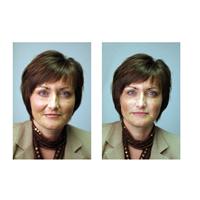
London: Laresse new dermal filler from the US and which says it is the most technologically advanced has launched in Europe.
It is synethetically made from absorbable medical polymers, bio-polymer which uses such small particles that it can be used for tiny wrinkles and is injected with the smallest of needles, reducing bruising.
Before and after photo right
Laresse is the creation of Californian company Fzio Med which manufacturers medical polymers. The company has been given regulator approval in Europe, including the UK, has yet to receive permission from the FDA for use on patients in the US.
The company claims that is a superior new generation filler because it has none of the drawbacks of previous fillers. For example, collagen which was sourced for animal sources such as bovine or porcine, required an allergy test. Hyaluronic acid (HA), a newer filler, which is a precursor to collagen in the human body is made from bacteria and has to go through a process known as cross-linking which slows down bodys natural absorption of the material.
It also is nonimmunogentic and non-clumping, says FzioMed.
Made by the Californian company FzioMed it was rolled out to cosmetic surgeons and medical surgeons in the UK earlier this year.
Dr Richard Berg, PhD, FzioMed Vice President of Research and Chief Science Officer said: Laresse is not made from HA so it has no bacterial or animal components, no cross-linking chemicals, and no gel particles. Its a pure, ultra-smooth, gel that can be used to shape facial contours and reduce the appearance of lines and wrinkles.
Laresse is a non-permanent filler which has been formulated from the companys experience in spinal surgery. The effects are said to last for six months and costs from $488 (£250 370).
For a practioner in the UK contact 07876 346 764 or visit www.laresse.com
The first positively flawless dermal filler
Non-animal, non-bacterial, non-permanent, non-crosslinked
Laresse – New Technology in dermal fillers – the facts
2006 Laresse: New technology with 3 new features: no animal contaminants, no crosslinkers, no particles, to provide less worry, less pain, thinner needles
1990s Hyaluronic Acid : 2 new features over collagen:
6 months vs. 3 months) and no pretreatment skin test.
Technology static for 10 years; NO NEW TECHNOLOGIES since HA (Many HA fillers, all the same)
HAs drawbacks not addressed: animal or bacterial source, crosslinkers and particles
1980s Bovine Collagen, First temporary filler, 3 months
What is Laresse?
Composed of 2 polymers mixed together in a dilute aqueous solution
Carboxymethylecellulose (CMC) & Polyethylene Oxide (PEO
Both CMC and PEO polymers have a high affinity for water producing a hydrogel, or water-containing gel.
Hyaluronic Acid Dermal Fillers
Because natural HA degrades rapidly, it must be chemically modified to be useful as a dermal filler
Chemicals such as BDDE (1,4-butane-diol diglycidyl ether, a known carcinogen) are used to cross-link HA molecules together to slow down degradation
All HA fillers require chemical cross-linking to achieve longer residence time in the dermis
Residues of cross-linking agents are toxic and may cause inflammation and hypersensitivity reactions
Cross-linking creates a gel made up of HA particles
Particle size limits delivery through a 30g needle (many fillers require 27g needle)
Particles can cause a less desirable cosmetic result
Laresse vs. HA Fillers
Laresse & HA are structurally similar, however they have 3 key differences
..
Animal or Bacteria Source
All HA fillers are derived from animal sources (rooster combs) or by bacterial whereas Laresse is derived from pure, absorbable, medical polymers
Cross-Linking
Natural HA degrades rapidly, so all HA must be chemically cross-linked to be useful as a dermal filler
Laresse needs no cross-linking to be an effective dermal filler
Particles
All HA fillers are made up of gel particles (due to cross-linking)
Laresse is completely smooth, free of gel particles
Laresse key points
1. Ultra-Smooth, Clear Gel, 30g Needle
2. Non-Permanent, Non-HA
3. Non-Particulate, Non-Clumping
4. Easier to Inject
5. Non-Bacterial
6. Non-Animal
7. Non-Immunogenic
8. No Cross-Linking Chemicals
9. Biocompatible, Safe



